Integrated Marketing Communications Report for SEA LIFE Melbourne
VerifiedAdded on 2022/09/18
|15
|3467
|30
Report
AI Summary
This report provides a comprehensive analysis of the integrated marketing communications (IMC) strategies employed by SEA LIFE Melbourne. It begins by outlining the communication model used and discussing key campaign decisions, including objectives based on the AIDA model, and the identification of target audiences (kids, parents, schools, marine enthusiasts). The report then delves into the Marcom mix, examining various channels such as advertising (print, digital, direct marketing), public relations, and event platforms, along with their objectives and synergy. A key focus is the message strategy, which includes insights into consumer-brand relationships and ensuring strategic consistency. The report also examines brand positioning strategies, emphasizing the importance of investing in existing attractions, exploiting strategic synergies, and developing themed attractions. The analysis covers demographic, geographic, psychographic, and behavioral segmentation of the target audience. The report concludes by highlighting the importance of a symbiotic relationship between marketing channels and platforms to create multiple impressions and drive consumer interest, with the ultimate goal of increasing customer engagement and profitability.

Running head: INTEGRATED MARKETING COMMUNICATIONS
Integrated Marketing Communications
Name of the Student
Name of the University
Author Note
Integrated Marketing Communications
Name of the Student
Name of the University
Author Note
Paraphrase This Document
Need a fresh take? Get an instant paraphrase of this document with our AI Paraphraser
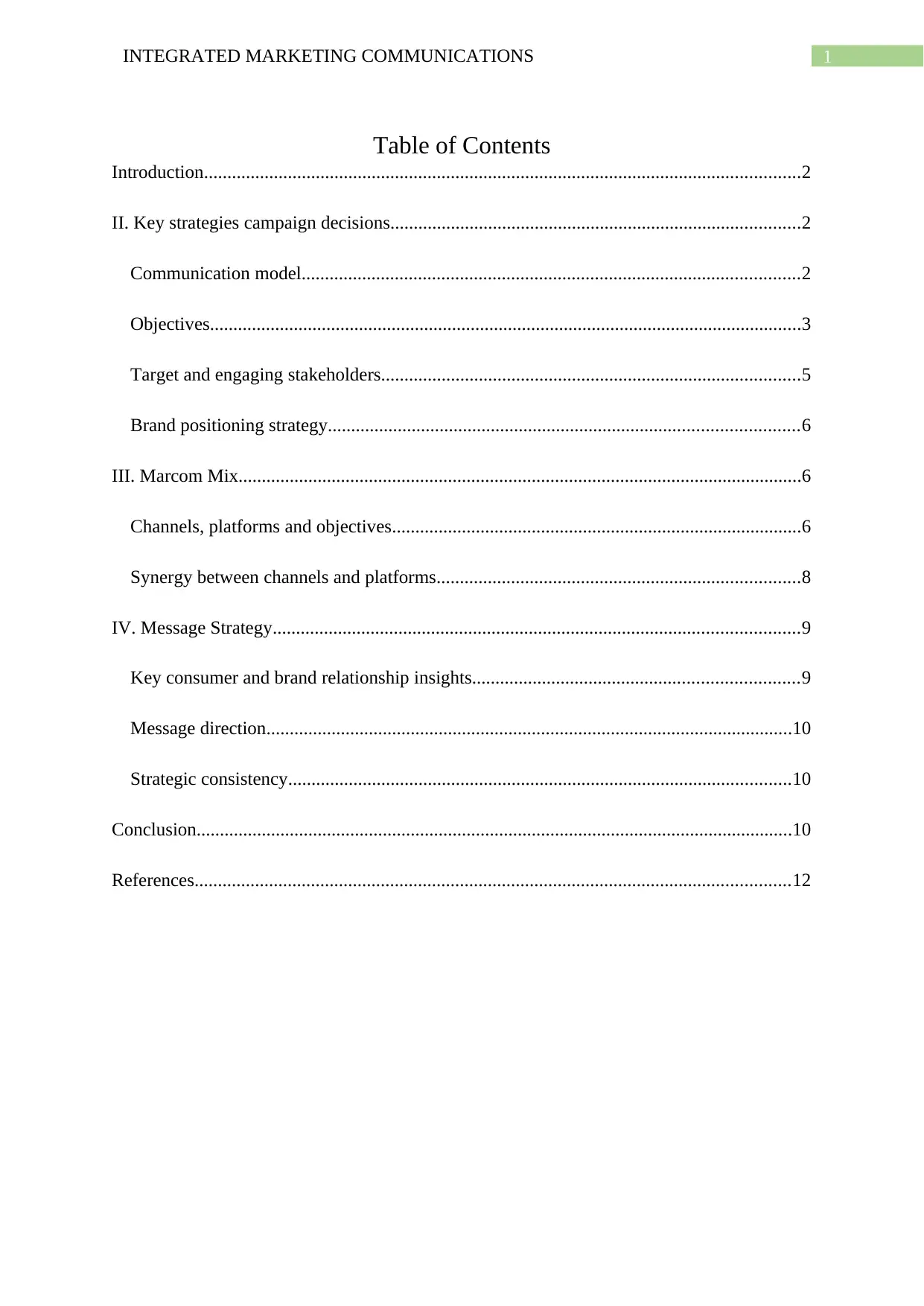
1INTEGRATED MARKETING COMMUNICATIONS
Table of Contents
Introduction................................................................................................................................2
II. Key strategies campaign decisions........................................................................................2
Communication model...........................................................................................................2
Objectives...............................................................................................................................3
Target and engaging stakeholders..........................................................................................5
Brand positioning strategy.....................................................................................................6
III. Marcom Mix.........................................................................................................................6
Channels, platforms and objectives........................................................................................6
Synergy between channels and platforms..............................................................................8
IV. Message Strategy.................................................................................................................9
Key consumer and brand relationship insights......................................................................9
Message direction.................................................................................................................10
Strategic consistency............................................................................................................10
Conclusion................................................................................................................................10
References................................................................................................................................12
Table of Contents
Introduction................................................................................................................................2
II. Key strategies campaign decisions........................................................................................2
Communication model...........................................................................................................2
Objectives...............................................................................................................................3
Target and engaging stakeholders..........................................................................................5
Brand positioning strategy.....................................................................................................6
III. Marcom Mix.........................................................................................................................6
Channels, platforms and objectives........................................................................................6
Synergy between channels and platforms..............................................................................8
IV. Message Strategy.................................................................................................................9
Key consumer and brand relationship insights......................................................................9
Message direction.................................................................................................................10
Strategic consistency............................................................................................................10
Conclusion................................................................................................................................10
References................................................................................................................................12
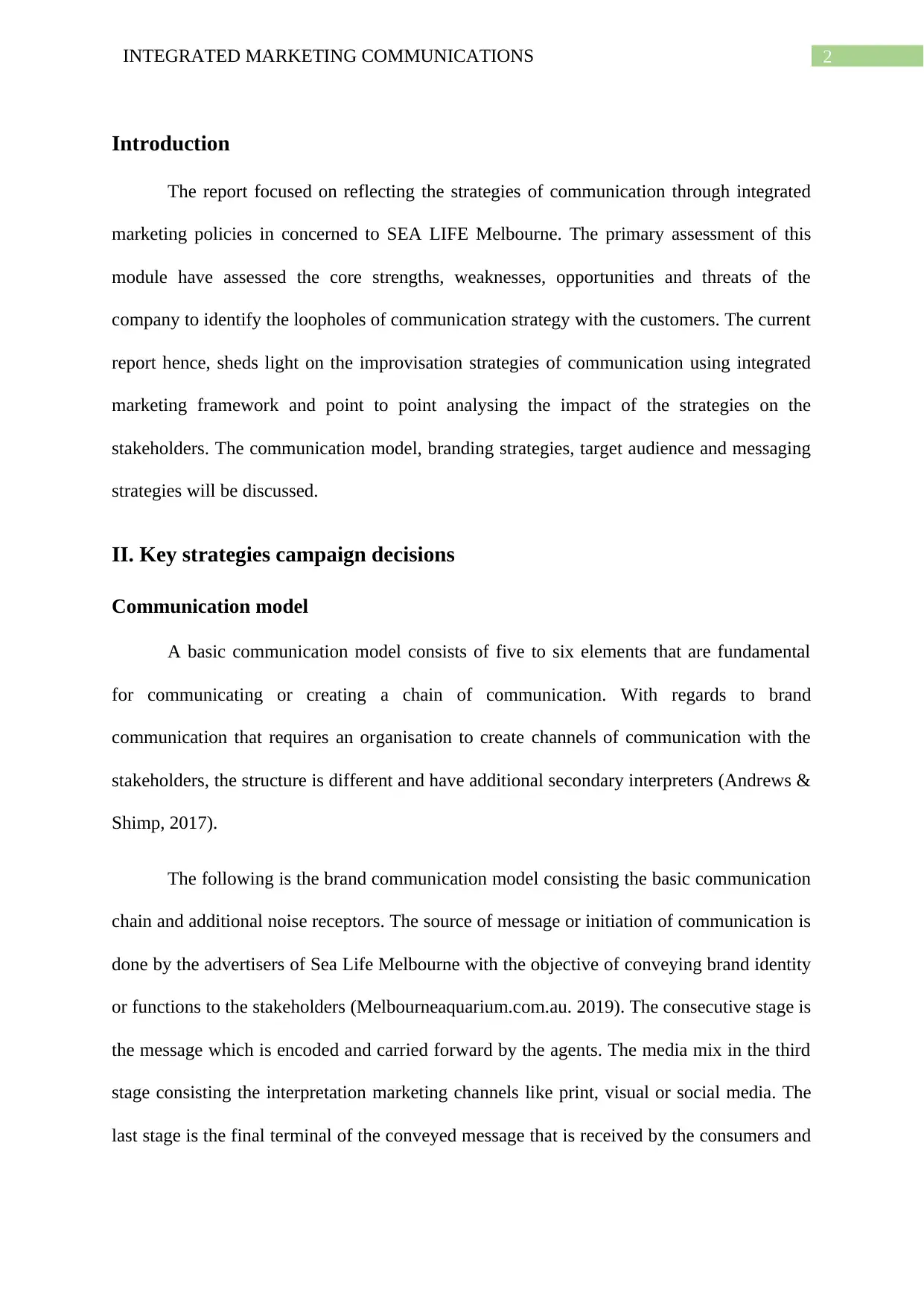
2INTEGRATED MARKETING COMMUNICATIONS
Introduction
The report focused on reflecting the strategies of communication through integrated
marketing policies in concerned to SEA LIFE Melbourne. The primary assessment of this
module have assessed the core strengths, weaknesses, opportunities and threats of the
company to identify the loopholes of communication strategy with the customers. The current
report hence, sheds light on the improvisation strategies of communication using integrated
marketing framework and point to point analysing the impact of the strategies on the
stakeholders. The communication model, branding strategies, target audience and messaging
strategies will be discussed.
II. Key strategies campaign decisions
Communication model
A basic communication model consists of five to six elements that are fundamental
for communicating or creating a chain of communication. With regards to brand
communication that requires an organisation to create channels of communication with the
stakeholders, the structure is different and have additional secondary interpreters (Andrews &
Shimp, 2017).
The following is the brand communication model consisting the basic communication
chain and additional noise receptors. The source of message or initiation of communication is
done by the advertisers of Sea Life Melbourne with the objective of conveying brand identity
or functions to the stakeholders (Melbourneaquarium.com.au. 2019). The consecutive stage is
the message which is encoded and carried forward by the agents. The media mix in the third
stage consisting the interpretation marketing channels like print, visual or social media. The
last stage is the final terminal of the conveyed message that is received by the consumers and
Introduction
The report focused on reflecting the strategies of communication through integrated
marketing policies in concerned to SEA LIFE Melbourne. The primary assessment of this
module have assessed the core strengths, weaknesses, opportunities and threats of the
company to identify the loopholes of communication strategy with the customers. The current
report hence, sheds light on the improvisation strategies of communication using integrated
marketing framework and point to point analysing the impact of the strategies on the
stakeholders. The communication model, branding strategies, target audience and messaging
strategies will be discussed.
II. Key strategies campaign decisions
Communication model
A basic communication model consists of five to six elements that are fundamental
for communicating or creating a chain of communication. With regards to brand
communication that requires an organisation to create channels of communication with the
stakeholders, the structure is different and have additional secondary interpreters (Andrews &
Shimp, 2017).
The following is the brand communication model consisting the basic communication
chain and additional noise receptors. The source of message or initiation of communication is
done by the advertisers of Sea Life Melbourne with the objective of conveying brand identity
or functions to the stakeholders (Melbourneaquarium.com.au. 2019). The consecutive stage is
the message which is encoded and carried forward by the agents. The media mix in the third
stage consisting the interpretation marketing channels like print, visual or social media. The
last stage is the final terminal of the conveyed message that is received by the consumers and
⊘ This is a preview!⊘
Do you want full access?
Subscribe today to unlock all pages.

Trusted by 1+ million students worldwide

3INTEGRATED MARKETING COMMUNICATIONS
a response is received termed as feedback. In between the second and the third stage, the
forums are interpreted by external and internal noises (Ots & Nyilasy, 2015).
The message to be conveyed by the agents through market communicating channels
are externally induced by public opinion, competition, marketing strategies and many more,
whereas internally by the information processing, perceived needs and opinions within the
channels (Batra & Keller, 2016). The feedback is then flown freely from the customers to the
source of message. Sea Life Melbourne has to create a cycle of communication with their
target audience maintaining the brand communication model. The message is to be based on
their service offerings that has to reach the target audience at a wider source of network
(Manser Payne, Peltier & Barger, 2017).
Objectives
AIDA model
a response is received termed as feedback. In between the second and the third stage, the
forums are interpreted by external and internal noises (Ots & Nyilasy, 2015).
The message to be conveyed by the agents through market communicating channels
are externally induced by public opinion, competition, marketing strategies and many more,
whereas internally by the information processing, perceived needs and opinions within the
channels (Batra & Keller, 2016). The feedback is then flown freely from the customers to the
source of message. Sea Life Melbourne has to create a cycle of communication with their
target audience maintaining the brand communication model. The message is to be based on
their service offerings that has to reach the target audience at a wider source of network
(Manser Payne, Peltier & Barger, 2017).
Objectives
AIDA model
Paraphrase This Document
Need a fresh take? Get an instant paraphrase of this document with our AI Paraphraser
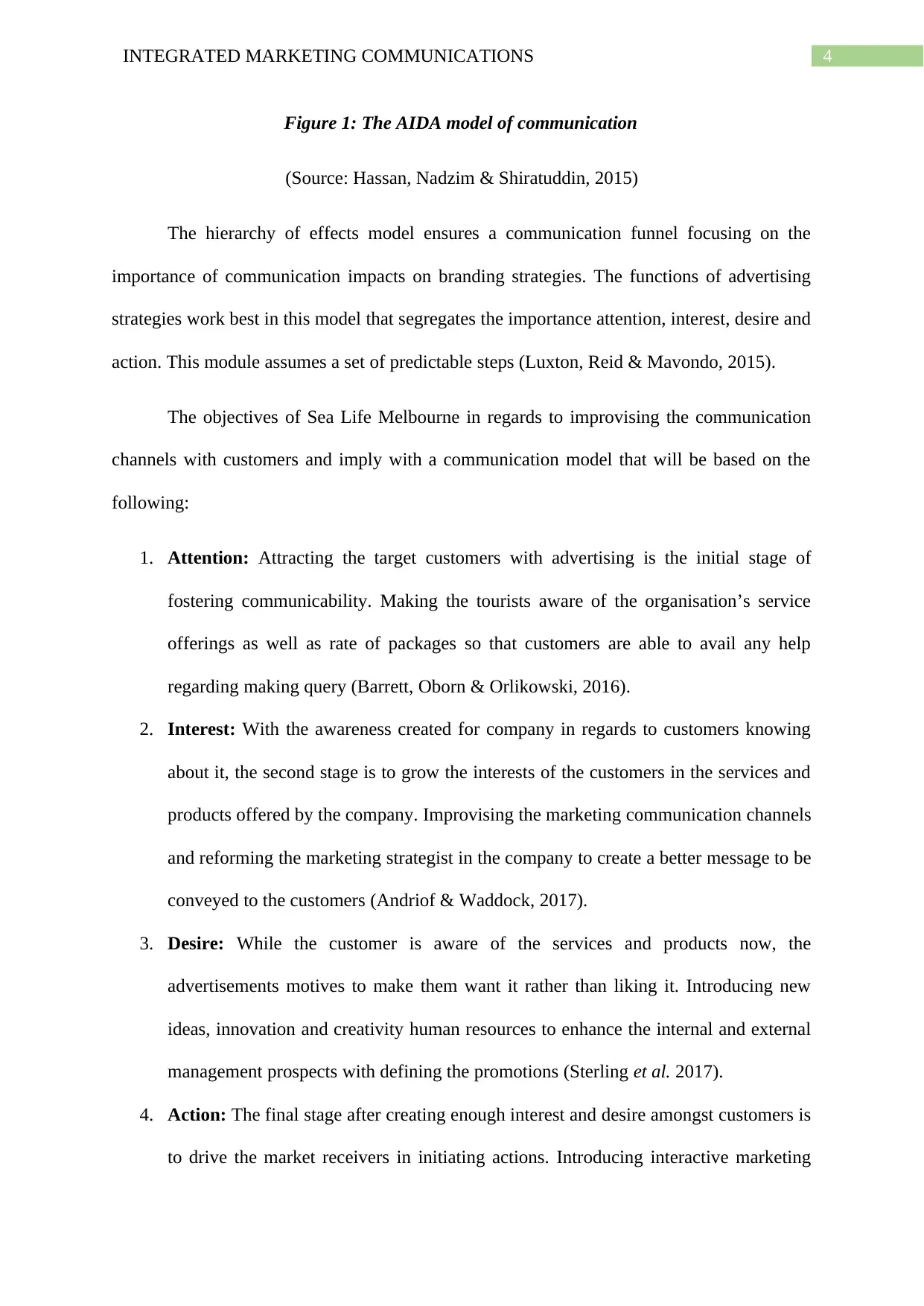
4INTEGRATED MARKETING COMMUNICATIONS
Figure 1: The AIDA model of communication
(Source: Hassan, Nadzim & Shiratuddin, 2015)
The hierarchy of effects model ensures a communication funnel focusing on the
importance of communication impacts on branding strategies. The functions of advertising
strategies work best in this model that segregates the importance attention, interest, desire and
action. This module assumes a set of predictable steps (Luxton, Reid & Mavondo, 2015).
The objectives of Sea Life Melbourne in regards to improvising the communication
channels with customers and imply with a communication model that will be based on the
following:
1. Attention: Attracting the target customers with advertising is the initial stage of
fostering communicability. Making the tourists aware of the organisation’s service
offerings as well as rate of packages so that customers are able to avail any help
regarding making query (Barrett, Oborn & Orlikowski, 2016).
2. Interest: With the awareness created for company in regards to customers knowing
about it, the second stage is to grow the interests of the customers in the services and
products offered by the company. Improvising the marketing communication channels
and reforming the marketing strategist in the company to create a better message to be
conveyed to the customers (Andriof & Waddock, 2017).
3. Desire: While the customer is aware of the services and products now, the
advertisements motives to make them want it rather than liking it. Introducing new
ideas, innovation and creativity human resources to enhance the internal and external
management prospects with defining the promotions (Sterling et al. 2017).
4. Action: The final stage after creating enough interest and desire amongst customers is
to drive the market receivers in initiating actions. Introducing interactive marketing
Figure 1: The AIDA model of communication
(Source: Hassan, Nadzim & Shiratuddin, 2015)
The hierarchy of effects model ensures a communication funnel focusing on the
importance of communication impacts on branding strategies. The functions of advertising
strategies work best in this model that segregates the importance attention, interest, desire and
action. This module assumes a set of predictable steps (Luxton, Reid & Mavondo, 2015).
The objectives of Sea Life Melbourne in regards to improvising the communication
channels with customers and imply with a communication model that will be based on the
following:
1. Attention: Attracting the target customers with advertising is the initial stage of
fostering communicability. Making the tourists aware of the organisation’s service
offerings as well as rate of packages so that customers are able to avail any help
regarding making query (Barrett, Oborn & Orlikowski, 2016).
2. Interest: With the awareness created for company in regards to customers knowing
about it, the second stage is to grow the interests of the customers in the services and
products offered by the company. Improvising the marketing communication channels
and reforming the marketing strategist in the company to create a better message to be
conveyed to the customers (Andriof & Waddock, 2017).
3. Desire: While the customer is aware of the services and products now, the
advertisements motives to make them want it rather than liking it. Introducing new
ideas, innovation and creativity human resources to enhance the internal and external
management prospects with defining the promotions (Sterling et al. 2017).
4. Action: The final stage after creating enough interest and desire amongst customers is
to drive the market receivers in initiating actions. Introducing interactive marketing

5INTEGRATED MARKETING COMMUNICATIONS
with the customers to understand their needs and work on their feedback (Castelló,
Etter & Årup Nielsen, 2016).
Target and engaging stakeholders
Demographic The target customers intended for attracting to Sea
Life Melbourne is kids and their parents as well as
schools (Sealifetrust.org.au. 2019).
Geographic The geographic segmentation strategy of the
organisation is based on the location targets.
Currently, Sea Life is targeting the entire country of
Australia as well as foreign countries as their target
where they represent the heritage of country.
Psychographic The psychographic segmentation of the audience
refers to the lifestyle they lead. For the purpose of
targeting audience based on psychographic aspects,
the fun loving persons who have love and passion
for marine life are targeted. The activities available
of entertainment in Sea Life is developed to entertain
all but there are specified audience who will enjoy it
altogether (Bilgili & Ozkul, 2015).
Behavioural The behavioural pattern indicates to the
segmentation of target audience who are enthusiast
about sea life and anything related to it. Apart from
children and their concerned guardians, the
organisation attracts potential marine entertainment
enthusiasts, learners, photographers and many more
with the customers to understand their needs and work on their feedback (Castelló,
Etter & Årup Nielsen, 2016).
Target and engaging stakeholders
Demographic The target customers intended for attracting to Sea
Life Melbourne is kids and their parents as well as
schools (Sealifetrust.org.au. 2019).
Geographic The geographic segmentation strategy of the
organisation is based on the location targets.
Currently, Sea Life is targeting the entire country of
Australia as well as foreign countries as their target
where they represent the heritage of country.
Psychographic The psychographic segmentation of the audience
refers to the lifestyle they lead. For the purpose of
targeting audience based on psychographic aspects,
the fun loving persons who have love and passion
for marine life are targeted. The activities available
of entertainment in Sea Life is developed to entertain
all but there are specified audience who will enjoy it
altogether (Bilgili & Ozkul, 2015).
Behavioural The behavioural pattern indicates to the
segmentation of target audience who are enthusiast
about sea life and anything related to it. Apart from
children and their concerned guardians, the
organisation attracts potential marine entertainment
enthusiasts, learners, photographers and many more
⊘ This is a preview!⊘
Do you want full access?
Subscribe today to unlock all pages.

Trusted by 1+ million students worldwide

6INTEGRATED MARKETING COMMUNICATIONS
(Wang, 2015).
Brand positioning strategy
The brand positioning strategies followed by the Sea Life Melbourne and its parent
company Merlin Entertainments are as follows:
Investing in the existing estates for growing the attracting factor in seeking the
interests of customers. With reference to the Sea Life Melbourne, the aquarium is to be
developed with renovation and reformed factors that will bring more entertainment.
Exploitation of strategic synergies keeps a motion of the organisation to grow in terms
of procurement, technology and activities. Sea Life Melbourne, on the footsteps of Merlin
entertainments, has to explore and exploit the synergies of the organisation in terms of
performing.
Developing the theme parks including Melbourne aquarium and other facilities of
displaying the marine life are to be developed for understanding the interests of the enthusiast
customers.
The existing places and attractions are to be developed with innovation that can
involve introducing new species in the aquarium or developing new game to be played
especially for the children.
III. Marcom Mix
Channels, platforms and objectives
The different channels associated in promoting the new technologies and reformations
of the company can be through advertising, direct marketing, sales promotion, personal
marketing, digital marketing and even public relations (Batum & Ersoy, 2016). With regards
(Wang, 2015).
Brand positioning strategy
The brand positioning strategies followed by the Sea Life Melbourne and its parent
company Merlin Entertainments are as follows:
Investing in the existing estates for growing the attracting factor in seeking the
interests of customers. With reference to the Sea Life Melbourne, the aquarium is to be
developed with renovation and reformed factors that will bring more entertainment.
Exploitation of strategic synergies keeps a motion of the organisation to grow in terms
of procurement, technology and activities. Sea Life Melbourne, on the footsteps of Merlin
entertainments, has to explore and exploit the synergies of the organisation in terms of
performing.
Developing the theme parks including Melbourne aquarium and other facilities of
displaying the marine life are to be developed for understanding the interests of the enthusiast
customers.
The existing places and attractions are to be developed with innovation that can
involve introducing new species in the aquarium or developing new game to be played
especially for the children.
III. Marcom Mix
Channels, platforms and objectives
The different channels associated in promoting the new technologies and reformations
of the company can be through advertising, direct marketing, sales promotion, personal
marketing, digital marketing and even public relations (Batum & Ersoy, 2016). With regards
Paraphrase This Document
Need a fresh take? Get an instant paraphrase of this document with our AI Paraphraser
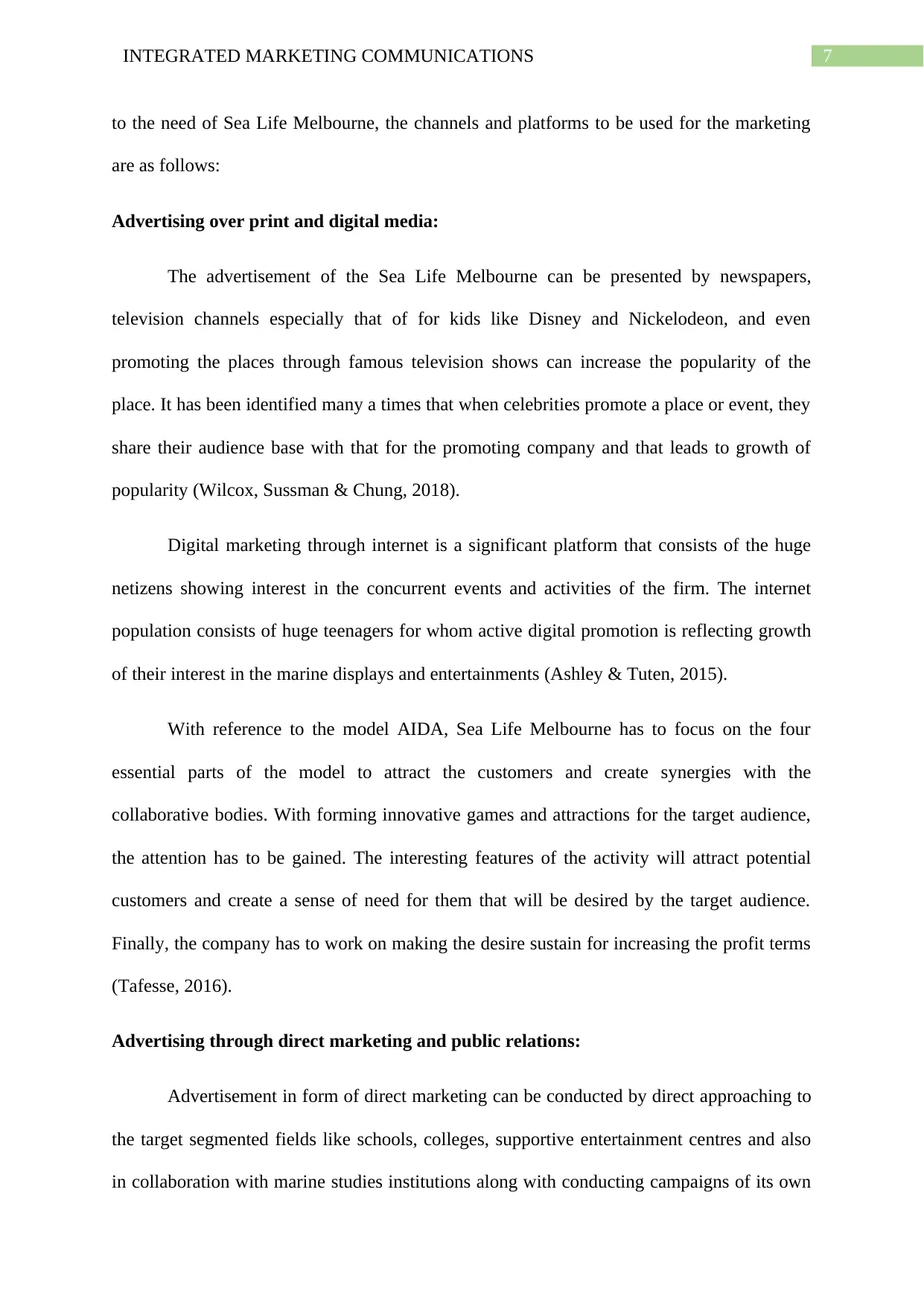
7INTEGRATED MARKETING COMMUNICATIONS
to the need of Sea Life Melbourne, the channels and platforms to be used for the marketing
are as follows:
Advertising over print and digital media:
The advertisement of the Sea Life Melbourne can be presented by newspapers,
television channels especially that of for kids like Disney and Nickelodeon, and even
promoting the places through famous television shows can increase the popularity of the
place. It has been identified many a times that when celebrities promote a place or event, they
share their audience base with that for the promoting company and that leads to growth of
popularity (Wilcox, Sussman & Chung, 2018).
Digital marketing through internet is a significant platform that consists of the huge
netizens showing interest in the concurrent events and activities of the firm. The internet
population consists of huge teenagers for whom active digital promotion is reflecting growth
of their interest in the marine displays and entertainments (Ashley & Tuten, 2015).
With reference to the model AIDA, Sea Life Melbourne has to focus on the four
essential parts of the model to attract the customers and create synergies with the
collaborative bodies. With forming innovative games and attractions for the target audience,
the attention has to be gained. The interesting features of the activity will attract potential
customers and create a sense of need for them that will be desired by the target audience.
Finally, the company has to work on making the desire sustain for increasing the profit terms
(Tafesse, 2016).
Advertising through direct marketing and public relations:
Advertisement in form of direct marketing can be conducted by direct approaching to
the target segmented fields like schools, colleges, supportive entertainment centres and also
in collaboration with marine studies institutions along with conducting campaigns of its own
to the need of Sea Life Melbourne, the channels and platforms to be used for the marketing
are as follows:
Advertising over print and digital media:
The advertisement of the Sea Life Melbourne can be presented by newspapers,
television channels especially that of for kids like Disney and Nickelodeon, and even
promoting the places through famous television shows can increase the popularity of the
place. It has been identified many a times that when celebrities promote a place or event, they
share their audience base with that for the promoting company and that leads to growth of
popularity (Wilcox, Sussman & Chung, 2018).
Digital marketing through internet is a significant platform that consists of the huge
netizens showing interest in the concurrent events and activities of the firm. The internet
population consists of huge teenagers for whom active digital promotion is reflecting growth
of their interest in the marine displays and entertainments (Ashley & Tuten, 2015).
With reference to the model AIDA, Sea Life Melbourne has to focus on the four
essential parts of the model to attract the customers and create synergies with the
collaborative bodies. With forming innovative games and attractions for the target audience,
the attention has to be gained. The interesting features of the activity will attract potential
customers and create a sense of need for them that will be desired by the target audience.
Finally, the company has to work on making the desire sustain for increasing the profit terms
(Tafesse, 2016).
Advertising through direct marketing and public relations:
Advertisement in form of direct marketing can be conducted by direct approaching to
the target segmented fields like schools, colleges, supportive entertainment centres and also
in collaboration with marine studies institutions along with conducting campaigns of its own
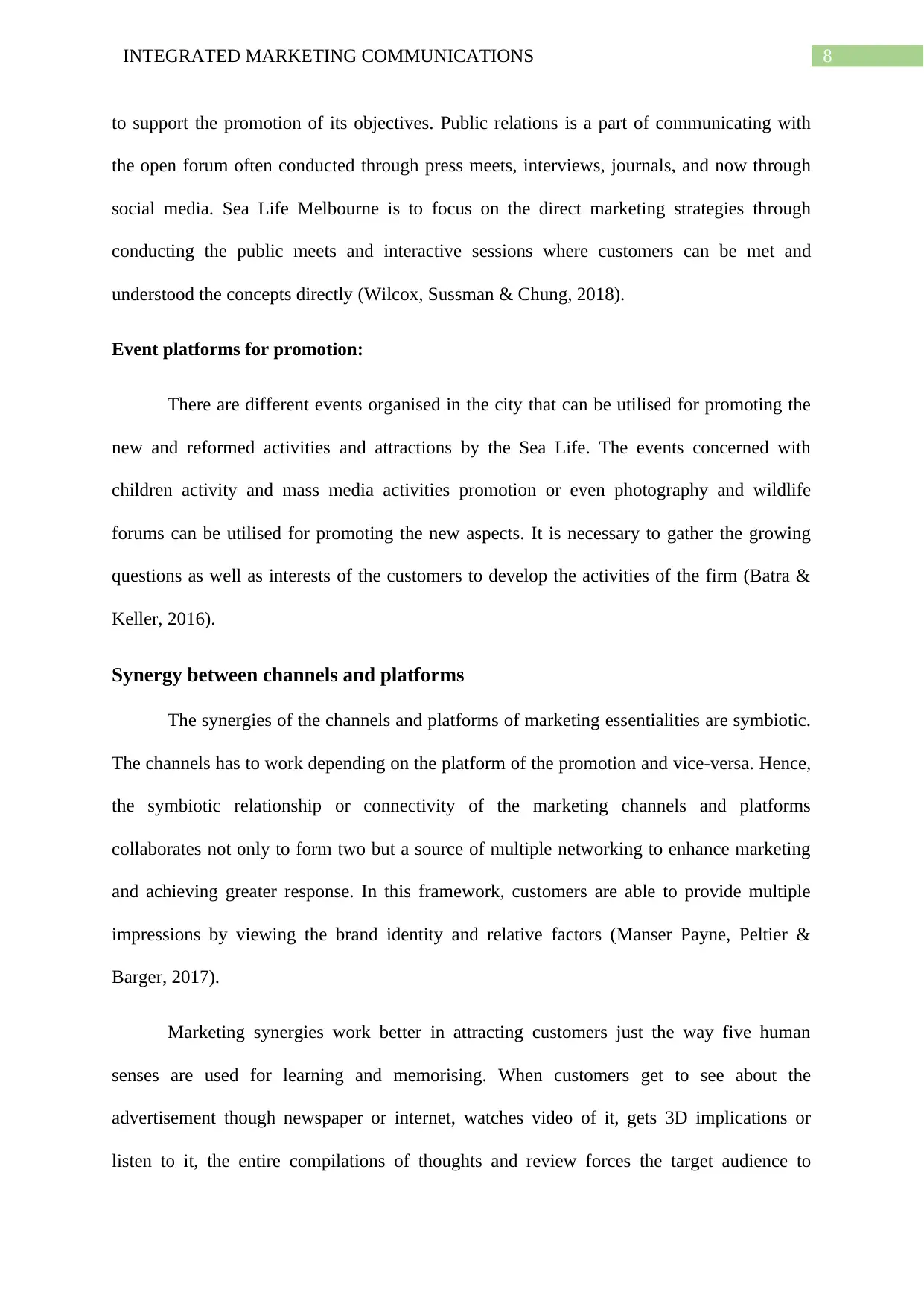
8INTEGRATED MARKETING COMMUNICATIONS
to support the promotion of its objectives. Public relations is a part of communicating with
the open forum often conducted through press meets, interviews, journals, and now through
social media. Sea Life Melbourne is to focus on the direct marketing strategies through
conducting the public meets and interactive sessions where customers can be met and
understood the concepts directly (Wilcox, Sussman & Chung, 2018).
Event platforms for promotion:
There are different events organised in the city that can be utilised for promoting the
new and reformed activities and attractions by the Sea Life. The events concerned with
children activity and mass media activities promotion or even photography and wildlife
forums can be utilised for promoting the new aspects. It is necessary to gather the growing
questions as well as interests of the customers to develop the activities of the firm (Batra &
Keller, 2016).
Synergy between channels and platforms
The synergies of the channels and platforms of marketing essentialities are symbiotic.
The channels has to work depending on the platform of the promotion and vice-versa. Hence,
the symbiotic relationship or connectivity of the marketing channels and platforms
collaborates not only to form two but a source of multiple networking to enhance marketing
and achieving greater response. In this framework, customers are able to provide multiple
impressions by viewing the brand identity and relative factors (Manser Payne, Peltier &
Barger, 2017).
Marketing synergies work better in attracting customers just the way five human
senses are used for learning and memorising. When customers get to see about the
advertisement though newspaper or internet, watches video of it, gets 3D implications or
listen to it, the entire compilations of thoughts and review forces the target audience to
to support the promotion of its objectives. Public relations is a part of communicating with
the open forum often conducted through press meets, interviews, journals, and now through
social media. Sea Life Melbourne is to focus on the direct marketing strategies through
conducting the public meets and interactive sessions where customers can be met and
understood the concepts directly (Wilcox, Sussman & Chung, 2018).
Event platforms for promotion:
There are different events organised in the city that can be utilised for promoting the
new and reformed activities and attractions by the Sea Life. The events concerned with
children activity and mass media activities promotion or even photography and wildlife
forums can be utilised for promoting the new aspects. It is necessary to gather the growing
questions as well as interests of the customers to develop the activities of the firm (Batra &
Keller, 2016).
Synergy between channels and platforms
The synergies of the channels and platforms of marketing essentialities are symbiotic.
The channels has to work depending on the platform of the promotion and vice-versa. Hence,
the symbiotic relationship or connectivity of the marketing channels and platforms
collaborates not only to form two but a source of multiple networking to enhance marketing
and achieving greater response. In this framework, customers are able to provide multiple
impressions by viewing the brand identity and relative factors (Manser Payne, Peltier &
Barger, 2017).
Marketing synergies work better in attracting customers just the way five human
senses are used for learning and memorising. When customers get to see about the
advertisement though newspaper or internet, watches video of it, gets 3D implications or
listen to it, the entire compilations of thoughts and review forces the target audience to
⊘ This is a preview!⊘
Do you want full access?
Subscribe today to unlock all pages.

Trusted by 1+ million students worldwide
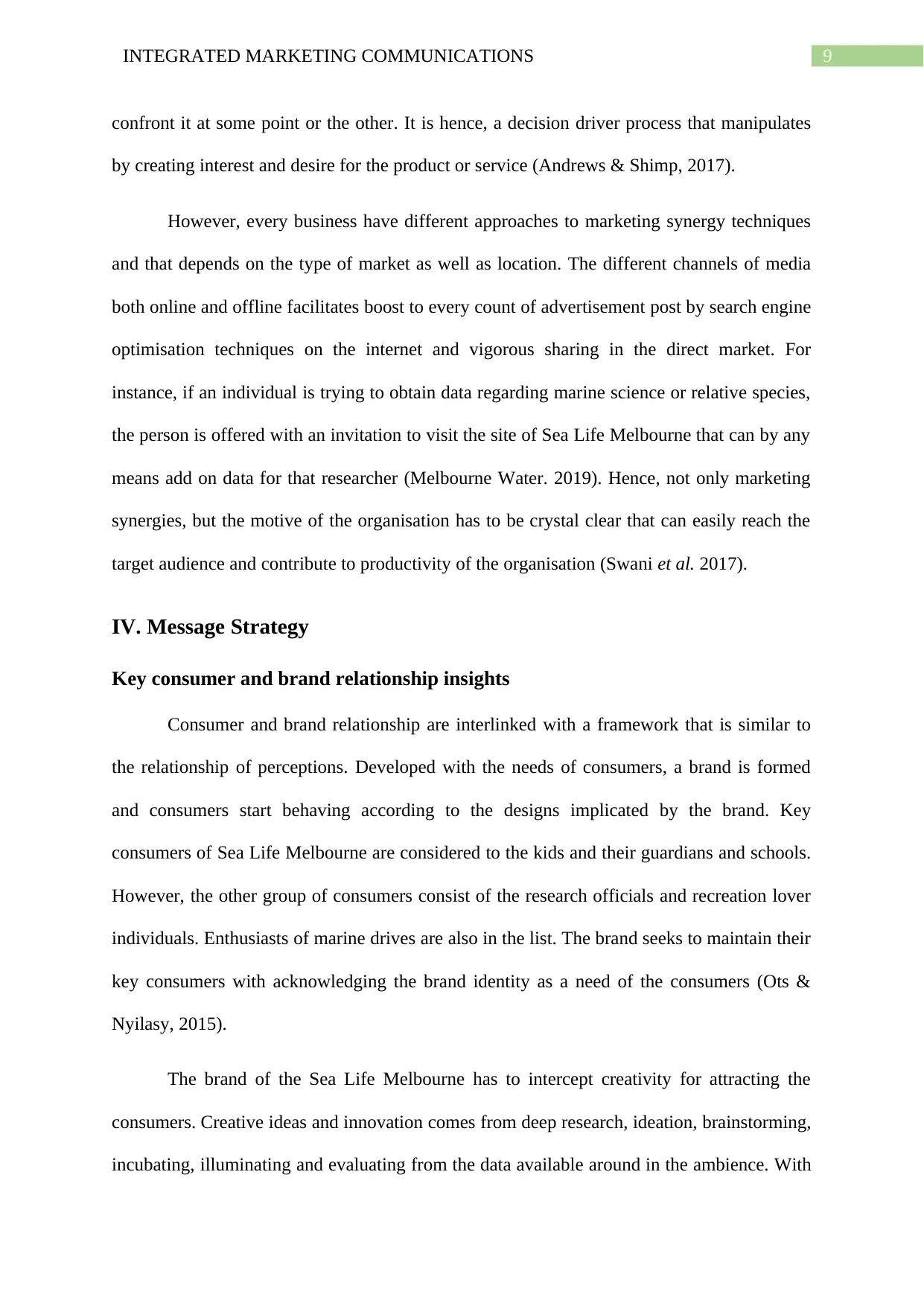
9INTEGRATED MARKETING COMMUNICATIONS
confront it at some point or the other. It is hence, a decision driver process that manipulates
by creating interest and desire for the product or service (Andrews & Shimp, 2017).
However, every business have different approaches to marketing synergy techniques
and that depends on the type of market as well as location. The different channels of media
both online and offline facilitates boost to every count of advertisement post by search engine
optimisation techniques on the internet and vigorous sharing in the direct market. For
instance, if an individual is trying to obtain data regarding marine science or relative species,
the person is offered with an invitation to visit the site of Sea Life Melbourne that can by any
means add on data for that researcher (Melbourne Water. 2019). Hence, not only marketing
synergies, but the motive of the organisation has to be crystal clear that can easily reach the
target audience and contribute to productivity of the organisation (Swani et al. 2017).
IV. Message Strategy
Key consumer and brand relationship insights
Consumer and brand relationship are interlinked with a framework that is similar to
the relationship of perceptions. Developed with the needs of consumers, a brand is formed
and consumers start behaving according to the designs implicated by the brand. Key
consumers of Sea Life Melbourne are considered to the kids and their guardians and schools.
However, the other group of consumers consist of the research officials and recreation lover
individuals. Enthusiasts of marine drives are also in the list. The brand seeks to maintain their
key consumers with acknowledging the brand identity as a need of the consumers (Ots &
Nyilasy, 2015).
The brand of the Sea Life Melbourne has to intercept creativity for attracting the
consumers. Creative ideas and innovation comes from deep research, ideation, brainstorming,
incubating, illuminating and evaluating from the data available around in the ambience. With
confront it at some point or the other. It is hence, a decision driver process that manipulates
by creating interest and desire for the product or service (Andrews & Shimp, 2017).
However, every business have different approaches to marketing synergy techniques
and that depends on the type of market as well as location. The different channels of media
both online and offline facilitates boost to every count of advertisement post by search engine
optimisation techniques on the internet and vigorous sharing in the direct market. For
instance, if an individual is trying to obtain data regarding marine science or relative species,
the person is offered with an invitation to visit the site of Sea Life Melbourne that can by any
means add on data for that researcher (Melbourne Water. 2019). Hence, not only marketing
synergies, but the motive of the organisation has to be crystal clear that can easily reach the
target audience and contribute to productivity of the organisation (Swani et al. 2017).
IV. Message Strategy
Key consumer and brand relationship insights
Consumer and brand relationship are interlinked with a framework that is similar to
the relationship of perceptions. Developed with the needs of consumers, a brand is formed
and consumers start behaving according to the designs implicated by the brand. Key
consumers of Sea Life Melbourne are considered to the kids and their guardians and schools.
However, the other group of consumers consist of the research officials and recreation lover
individuals. Enthusiasts of marine drives are also in the list. The brand seeks to maintain their
key consumers with acknowledging the brand identity as a need of the consumers (Ots &
Nyilasy, 2015).
The brand of the Sea Life Melbourne has to intercept creativity for attracting the
consumers. Creative ideas and innovation comes from deep research, ideation, brainstorming,
incubating, illuminating and evaluating from the data available around in the ambience. With
Paraphrase This Document
Need a fresh take? Get an instant paraphrase of this document with our AI Paraphraser
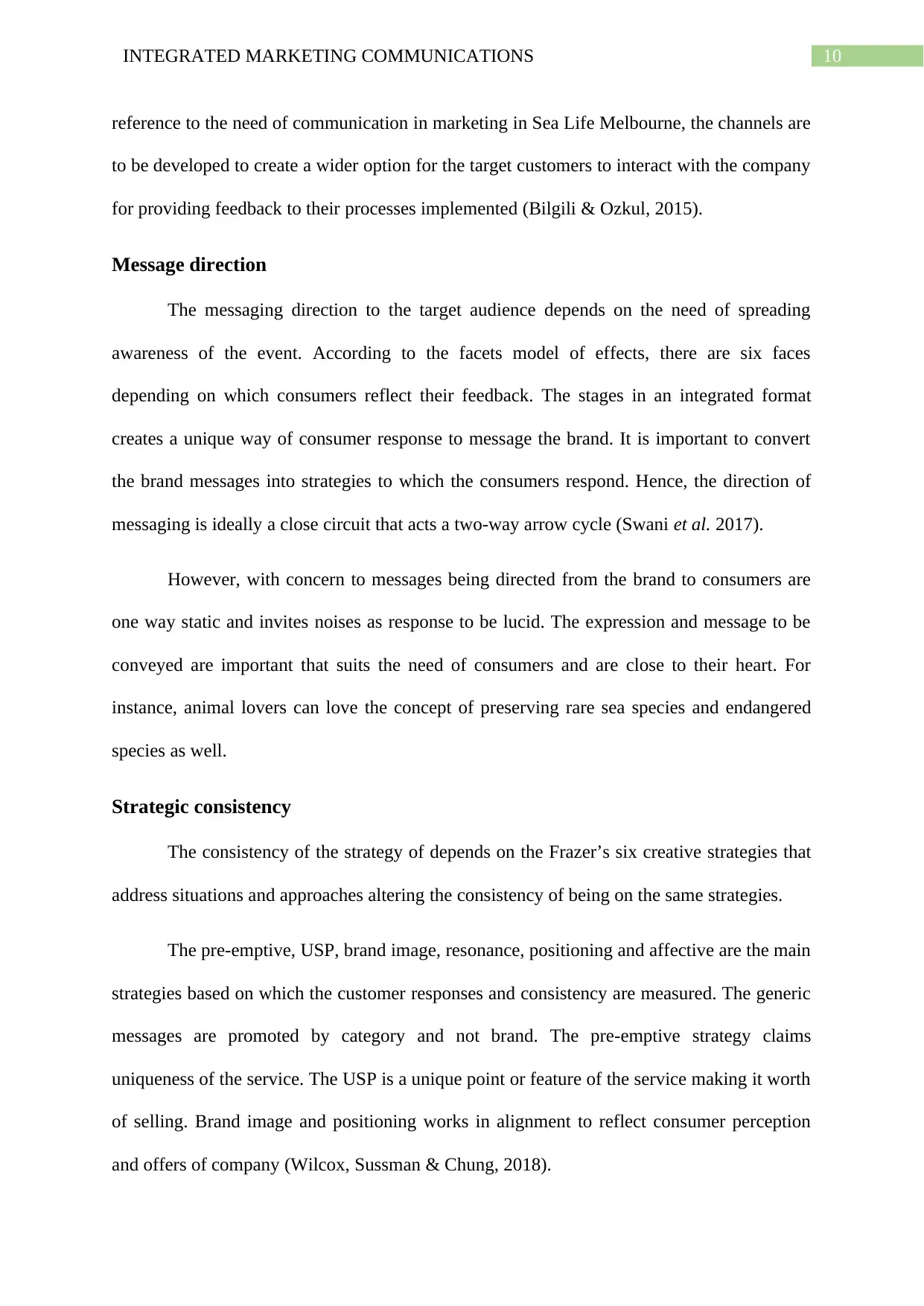
10INTEGRATED MARKETING COMMUNICATIONS
reference to the need of communication in marketing in Sea Life Melbourne, the channels are
to be developed to create a wider option for the target customers to interact with the company
for providing feedback to their processes implemented (Bilgili & Ozkul, 2015).
Message direction
The messaging direction to the target audience depends on the need of spreading
awareness of the event. According to the facets model of effects, there are six faces
depending on which consumers reflect their feedback. The stages in an integrated format
creates a unique way of consumer response to message the brand. It is important to convert
the brand messages into strategies to which the consumers respond. Hence, the direction of
messaging is ideally a close circuit that acts a two-way arrow cycle (Swani et al. 2017).
However, with concern to messages being directed from the brand to consumers are
one way static and invites noises as response to be lucid. The expression and message to be
conveyed are important that suits the need of consumers and are close to their heart. For
instance, animal lovers can love the concept of preserving rare sea species and endangered
species as well.
Strategic consistency
The consistency of the strategy of depends on the Frazer’s six creative strategies that
address situations and approaches altering the consistency of being on the same strategies.
The pre-emptive, USP, brand image, resonance, positioning and affective are the main
strategies based on which the customer responses and consistency are measured. The generic
messages are promoted by category and not brand. The pre-emptive strategy claims
uniqueness of the service. The USP is a unique point or feature of the service making it worth
of selling. Brand image and positioning works in alignment to reflect consumer perception
and offers of company (Wilcox, Sussman & Chung, 2018).
reference to the need of communication in marketing in Sea Life Melbourne, the channels are
to be developed to create a wider option for the target customers to interact with the company
for providing feedback to their processes implemented (Bilgili & Ozkul, 2015).
Message direction
The messaging direction to the target audience depends on the need of spreading
awareness of the event. According to the facets model of effects, there are six faces
depending on which consumers reflect their feedback. The stages in an integrated format
creates a unique way of consumer response to message the brand. It is important to convert
the brand messages into strategies to which the consumers respond. Hence, the direction of
messaging is ideally a close circuit that acts a two-way arrow cycle (Swani et al. 2017).
However, with concern to messages being directed from the brand to consumers are
one way static and invites noises as response to be lucid. The expression and message to be
conveyed are important that suits the need of consumers and are close to their heart. For
instance, animal lovers can love the concept of preserving rare sea species and endangered
species as well.
Strategic consistency
The consistency of the strategy of depends on the Frazer’s six creative strategies that
address situations and approaches altering the consistency of being on the same strategies.
The pre-emptive, USP, brand image, resonance, positioning and affective are the main
strategies based on which the customer responses and consistency are measured. The generic
messages are promoted by category and not brand. The pre-emptive strategy claims
uniqueness of the service. The USP is a unique point or feature of the service making it worth
of selling. Brand image and positioning works in alignment to reflect consumer perception
and offers of company (Wilcox, Sussman & Chung, 2018).
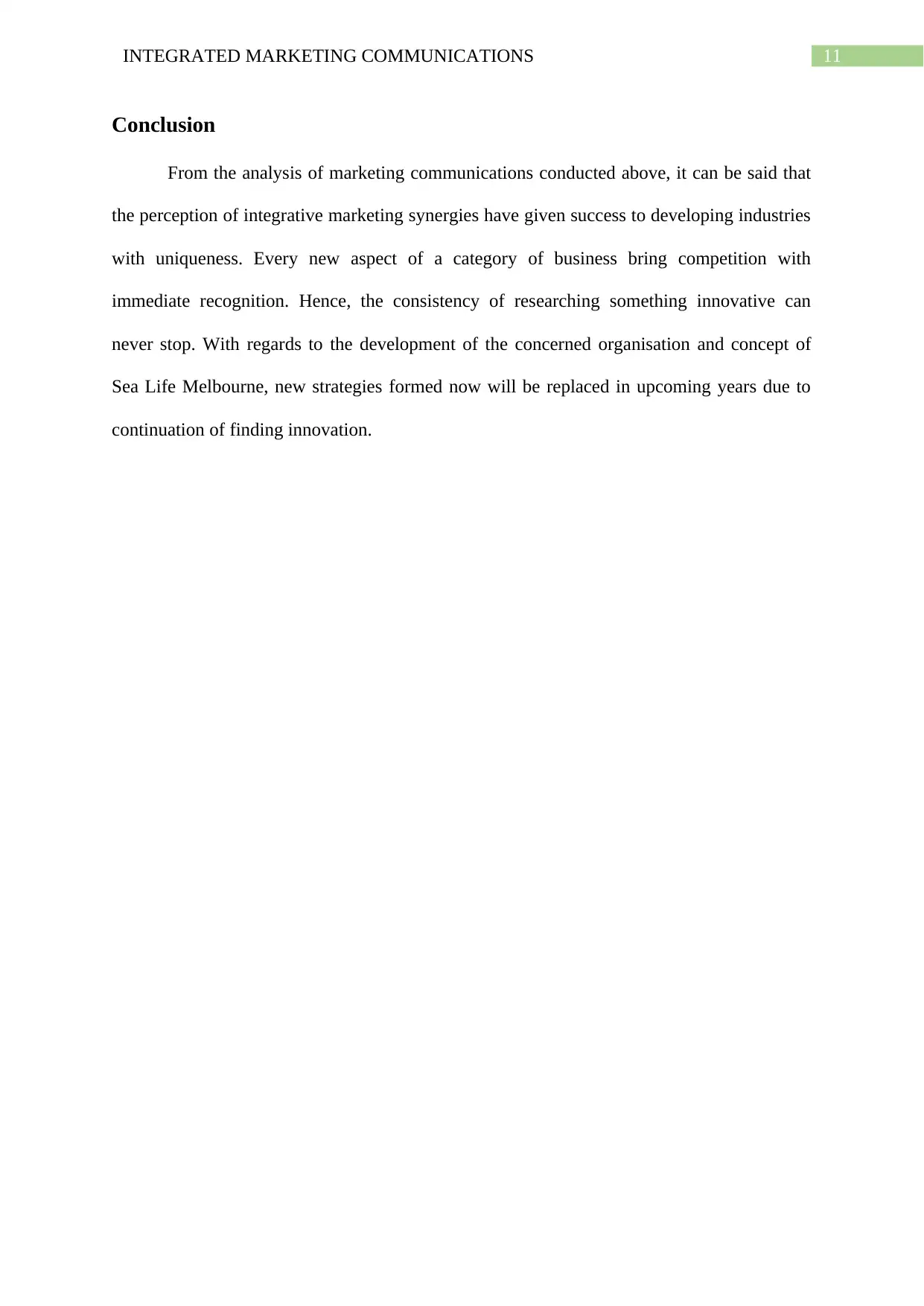
11INTEGRATED MARKETING COMMUNICATIONS
Conclusion
From the analysis of marketing communications conducted above, it can be said that
the perception of integrative marketing synergies have given success to developing industries
with uniqueness. Every new aspect of a category of business bring competition with
immediate recognition. Hence, the consistency of researching something innovative can
never stop. With regards to the development of the concerned organisation and concept of
Sea Life Melbourne, new strategies formed now will be replaced in upcoming years due to
continuation of finding innovation.
Conclusion
From the analysis of marketing communications conducted above, it can be said that
the perception of integrative marketing synergies have given success to developing industries
with uniqueness. Every new aspect of a category of business bring competition with
immediate recognition. Hence, the consistency of researching something innovative can
never stop. With regards to the development of the concerned organisation and concept of
Sea Life Melbourne, new strategies formed now will be replaced in upcoming years due to
continuation of finding innovation.
⊘ This is a preview!⊘
Do you want full access?
Subscribe today to unlock all pages.

Trusted by 1+ million students worldwide
1 out of 15
Related Documents
Your All-in-One AI-Powered Toolkit for Academic Success.
+13062052269
info@desklib.com
Available 24*7 on WhatsApp / Email
![[object Object]](/_next/static/media/star-bottom.7253800d.svg)
Unlock your academic potential
Copyright © 2020–2025 A2Z Services. All Rights Reserved. Developed and managed by ZUCOL.



